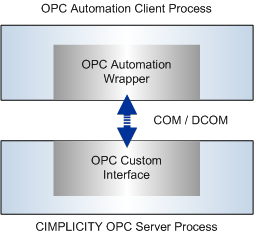Refer to the OPC Foundation specification documents for more information on details presented in this section.
|
OPC Specification Compliance. |
|
|
COM Program ID. |
|
|
Supported Data Access Custom Interfaces. |
|
|
Supported Automation Interfaces. |
|
|
OPC Group Object Percent Dead Band. |
|
|
Blobs. |
OPC Specification Compliance
The CIMPLICITY OPC Server is compliant with the following OPC standards:
![]() Data Access Custom Interface
Standard V3.0, V2.0, and V1.0a.
Data Access Custom Interface
Standard V3.0, V2.0, and V1.0a.
![]() Data Access Automation Interface
Standard V3.0 and V2.0.
Data Access Automation Interface
Standard V3.0 and V2.0.
![]() Note: For specific information about the
differences between 2.x and 3.x OPC specifications, refer to the
OPC Foundation web site.
Note: For specific information about the
differences between 2.x and 3.x OPC specifications, refer to the
OPC Foundation web site.
COM Program ID
Once installed, the CIMPLICITY OPC Server is typically referenced by an OPC client by its ProgID (program ID). The ProgID for the CIMPLICITY OPC Server is:
CIMPLICITY.HMI.OPCServer
The OPC Server's unique CLSID (class ID) is:
{B01241E8-921B-11d2-B43F-204C4F4F5020}
Supported Data Access Custom Interfaces
The CIMPLICITY OPC Server implements the following COM interfaces. Note that standard COM interfaces are not listed.
|
IOPCServer |
IOPCBrowseServerAddressSpace |
|
IOPCItemProperties |
IConnectionPointContainer |
|
IOPCCommon |
IOPCGroupStateMgt |
|
IOPCASyncIO2 |
IOPCAsyncIO |
|
IOPCItemMgt |
IConnectionPointContainer |
|
IOPCSyncIO |
IDataObject |
|
EnumOPCItemAttributes |
IEnumOPCItemAttributes |
Supported Automation Interfaces
The CIMPLICITY OPC Server relies on the standard automation wrapper supplied by the OPC Foundation.
The automation wrapper interacts with the automation client (e.g. Visual Basic for Applications script) and the custom interface of the CIMPLICITY OPC Server.

![]() Notes
Notes
![]() The automation wrapper
executes in-process with the automation client.
The automation wrapper
executes in-process with the automation client.
![]() Selection of the type of
interface to use, custom or automation, depends on the goals of the
client application developer.
Selection of the type of
interface to use, custom or automation, depends on the goals of the
client application developer.
Adhoc client applications written in Microsoft Visual Basic (for example) typically use the automation interface.
![]() Automation interfaces are easy to
use in the VB (and VBA) development environments.
Automation interfaces are easy to
use in the VB (and VBA) development environments.
However, the automation interface is slower at execution time.
![]() Applications written in Microsoft
Visual C++ (for example) use the custom interface.
Applications written in Microsoft
Visual C++ (for example) use the custom interface.
This is the most efficient interface, but it is more complex to use.
OPC Group Object Percent Dead Band
Percent dead-banding is not supported directly by the CIMPLICITY OPC Server when a client configures an OPC group.
The CIMPLICITY runtime database provides support for dead band change notifications.
Dead banding is configured when a point is added to a CIMPLICITY project.
If a client specifies a percent dead-band value for a group, the value is ignored.
Change notifications are reported to an OPC client based on the dead-banding configured for a point in the CIMPLICITY project.
The CIMPLICITY OPC Server does not support the use of blobs. Refer to the Data Access specification for more information on blobs.
|
CIMPLICITY OPC Server technical notes. |